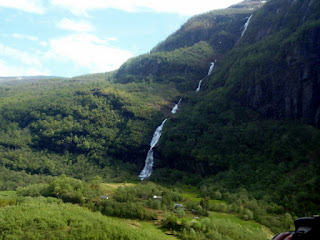 It takes 36 hours to cover the several hundred miles from Tromso south to Kristiansund. These ports, like all the others we have come across on our trip, are tucked far up fjords, offering the perfect playground for small boats of every description.
It takes 36 hours to cover the several hundred miles from Tromso south to Kristiansund. These ports, like all the others we have come across on our trip, are tucked far up fjords, offering the perfect playground for small boats of every description. 
For much of the journey Norway’s hazy grey coast remains in view. The ship passes the occasional oil platform as well as the strangely shaped flat-bed supply boats that service them.

Kristiansund emerged as another low-rise, clean cut town, sprawled across the flanks of several bridge-linked islands. The town centre had been completely rebuilt after the war, our excursion guide informed us, after being heavily bombed by the invading German army.

Our tour took us from the vast oil port to a spectacular church.

It proved highly controversial at the time of its building, attracting fierce criticism from the town’s more conservative residents. Over the years it had become accepted and finally a source of local pride.

Our final stop was a former cod-salting and drying factory that now serves as a museum. The cod was dried, initially on rocks surrounding the factory and later in ovens, according to a formula discovered by the Portuguese.

It was exported in its entirety, much of it to Portugal where it is a food staple known as bacalhau. The same word is used in Norway to describe, not the dried fish itself, but a stew made from it.

We were all offered samples of it to taste. Jones pronounced it delicious.

Our final and most memorable port of call was the tiny hamlet of Flam. It takes the best part of two hours to sail up the long fjord at the end of which Flam lies. Houses and farmsteads line much of the fjord, many of them set on steep slopes. It’s a real puzzle to see how people reach them.
 Flam itself appears entirely surrounded by abrupt hills, rising to about 1,000 metres. The hamlet is famous for its railway, a track that rises steeply via multiple tunnels through the hills to connect to the main line, although it’s hard to see as one approaches where the track exits Flam. Another cruise ship occupied the hamlet’s single berth, forcing us to anchor in the sound and go ashore by tender.
Flam itself appears entirely surrounded by abrupt hills, rising to about 1,000 metres. The hamlet is famous for its railway, a track that rises steeply via multiple tunnels through the hills to connect to the main line, although it’s hard to see as one approaches where the track exits Flam. Another cruise ship occupied the hamlet’s single berth, forcing us to anchor in the sound and go ashore by tender.
It was only after making our way through the gauntlet of souvenir shops and crossing the river that we spotted the narrow valley carrying the track. As the local museum records, it took years of gruelling labour to construct the railway and to dig by hand the numerous tunnels and embankments.

We had booked a rail and hike excursion that took us to the top of the valley where we left the train to zigzag back down the narrow supply track on foot.

The going was gravelly and full of runnels cut by rivulets of water. There must have been about 40 in our party.
 The valley was as spectacular as it was steep. Streams of water came gushing in explosions of spray down the cliff face to join the swirling river whose course we followed.
The valley was as spectacular as it was steep. Streams of water came gushing in explosions of spray down the cliff face to join the swirling river whose course we followed.  ONE GUIDE SEATED, THE OTHER STANDING
ONE GUIDE SEATED, THE OTHER STANDINGOur guide was a super-fit woman who looked 30 but must have been in her 50s for she said she’d been guiding for 36 years. She spoke fluent English and certainly knew her stuff. It’s 20 kilometres from the plateau down to the fjord.

We walked the first 10 to join the train again gratefully at the mid-point station. By then my legs were shaking. Although the going was hard, it was satisfying in the extreme and we thought it the best possible way to finish our visit to Norway.
 So here we are on a Saturday afternoon, thumping through the North Sea, past the occasional oil rig, towards Newcastle where we disembark early on Sunday morning. British Airways then flies us London. There we join Llewellyn and Lucia for a day or two before continuing our travels in the south west.
So here we are on a Saturday afternoon, thumping through the North Sea, past the occasional oil rig, towards Newcastle where we disembark early on Sunday morning. British Airways then flies us London. There we join Llewellyn and Lucia for a day or two before continuing our travels in the south west.
No comments:
Post a Comment